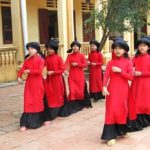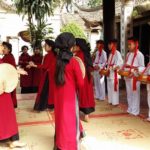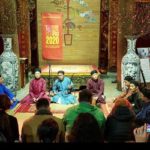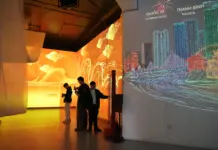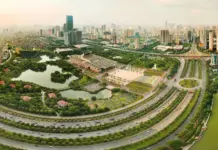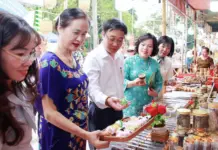Vietnam has made significant strides in the digitization of cultural and artistic assets in recent years, especially after the outbreak of the Covid-19 pandemic, which Professor Julia Gaimster, Dean of the Faculty of Communication and Design at RMIT University, viewed as an outstanding achievement five years after the Prime Minister’s Strategy for the Development of the Cultural Industry came into effect.
Increasing the amount of digital cultural content can help attract domestic audiences and provide global viewers with insights into modern Vietnamese culture, Gaimster said.
Fostering a digital culture
People in Hanoi were taken aback in 2019 when they peered through their smartphone screens and saw that the Cho Hom (Hom Market in Hoan Kiem District) skylight had turned into an airborne pond. It was part of the “Into Thin Air” exhibition organized by Manzi Art Space. That pond is a lacquered piece of art on glass that has a moving effect because of augmented reality (AR) technology. Digital platforms make it possible to engage with a wider range of people and promote awareness of lesser-known facets of culture Emma Duester from RMIT University, believes that Vietnamese contemporary art and culture are helping change the world’s stereotypical perception of traditional customs, wars and tourist sites in Vietnam.
| A foreign tourist uses the Into the Thin Air 2 app to view a virtual installation at Dong Kinh Nghia Thuc Square. Photo courtesy of Manzi Art Space |
Emma Duester and her partner, Michal Teague, took part in a study into the digital transformation of Vietnamese culture and art. They pointed to a lack of funding, human resources, and technological resources as barriers to digitizing arts and culture.
“Aside from strengthening policies aimed at preserving cultural and traditional cultural heritage, Vietnam should give more thought to digitizing archives and making them available to the public. That is the most effective approach to preserve culture,” said Duester.
This expert is also of the opinion that in the future, Vietnam will be in need of a shared, sustainable and accessible digital platform for the display of prominent cultural and artistic works. This allows the general public at home and abroad as well as cultural experts, educators and researchers, to have access to them.
Duester believes it is necessary to adopt a “digital culture” policy for Vietnam to ensure systematic and sustainable development of cultural industries and educate the public about copyright and other forms of online intellectual property ownership.
| Cho Hom (Hom Market in Hoan Kiem District) skylight is turned into an airborne pond. Photo: Manzi |
More specifically, Michal Teague said that galleries, libraries, archives and museums in Vietnam need to define and understand their target audience to focus their messages properly.
The expert emphasized that if the Internet repository of Vietnamese culture and art is too rudimentary, educators and researchers are forced to rely on Western sources.
“To create live and digital content platforms that will appeal to local and worldwide audiences, she added, these institutions need to work together and involve relevant sectors such as hospitality, tourism, education, manufacturing, and public transport.
New cultural investment strategies
Nguyen Thi Quy Phuong, a former deputy director of the Institute for Research in Journalism and Communication, offers five suggestions for developing Vietnam’s cultural industry based on her expertise in researching the challenges of globalization.
The State should first categorize businesses in the cultural industry according to operational expertise, size, and recognition of specific business models of some particular professions.
Based on these models and occupations, Enterprise Law and Labor Law define them and lay the groundwork for the development of professional organizations and individuals in the sector. Second, it’s important to make it easier for businesses in the cultural sector to obtain funding and gather the resources they need to invest in new product development.
| The movie Godfather by Tran Thanh which cost VND23 billion (US$ 1 million) to produce in 2021, returned VND600 billion (US$ 26 million). |
“This is beneficial for both banks and investors because cultural industrial products often provide returns many times the investment value. The movie Godfather by Tran Thanh which cost VND 23 billion (US$ 1 million) to produce in 2021, returned VND 600 billion (US$ 26 million),” according to Quy Phuong.
Third, according to PhD Quy Phuong, the Government can implement tax incentives for the private sector to boldly spend their own money to build studios, infrastructure for cultural tourism, and open creative spaces, in other words, to attract much-needed investment in the cultural industry.
Fourth, State assistance is required to encourage the creation of investment funds for the cultural industry and cultural sector promotion and development associations and agencies along the lines of the National Fund for the Arts.
Fifth, Government intervention is needed to ensure fairness and healthy competition between domestic and foreign enterprises.
Associate Professor Bui Hoai Son, a Standing member of the National Assembly’s Committee on Culture and Education, expressed interest in the idea of creating new investment models for the cultural industry to help cultural institutions diversify their revenue streams, do business and access different types of financing (including bank loans) and engage in public-private partnerships (PPP).
In his opinion, human creativity – not coal, oil, or any other resource – is the most valuable resource in the modern world. Not only is it the greatest strength, but creativity is also a renewable resource always available. The universal rule is that a nation will advance if it harnesses the creative talents of its people.
“If the policies are put into practice comprehensively, Vietnam can fully tap the sources of creativity and build a cultural industry with healthy and sustainable development,” he said.
| Thang Long Royal Citadel in Hanoi. Photo: VNA |
Architect Melanie Doremus, General Director of AREP South Asia – a consulting firm specializing in architecture and design, holds the same opinion and believes that developing the cultural and creative industries is a sustainable strategy to preserve heritage in contemporary society.
According to her, heritage should not be viewed as a mere component of integrated planning; rather, it should serve as an “umbrella” covering all facets of development, including those related to environment, agriculture, industry and tourism.
“Heritage is a guiding element for the entire local development strategy. It is necessary to elevate heritage to become a driving force of development,” emphasized architect Melanie Doremus.
She used Hue’s heritage preservation as an example, saying the city has all the necessary resources and ideal conditions to draw tourists thanks to its festivals, colleges, rich history, and urban setting. Citing UNESCO’s definition, Melanie Doremus said that Creative Cities are cities that have created effective conditions for culture and creativity to contribute to the community’s socio-economic development.
She underlined that Hue Festival is a powerful catalyst for transforming Hue into a Creative Cultural City, as evidenced by the fact that this event has become a tourist magnet of Hue and surrounding localities. For Hanoi, the same goes for culture and creativity.





